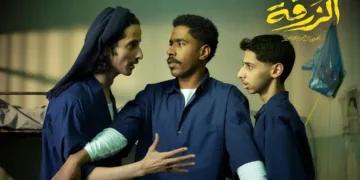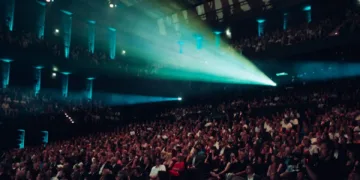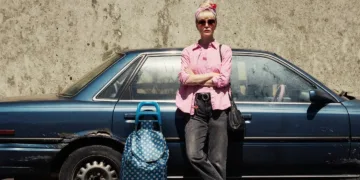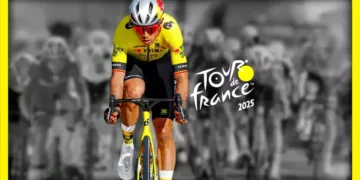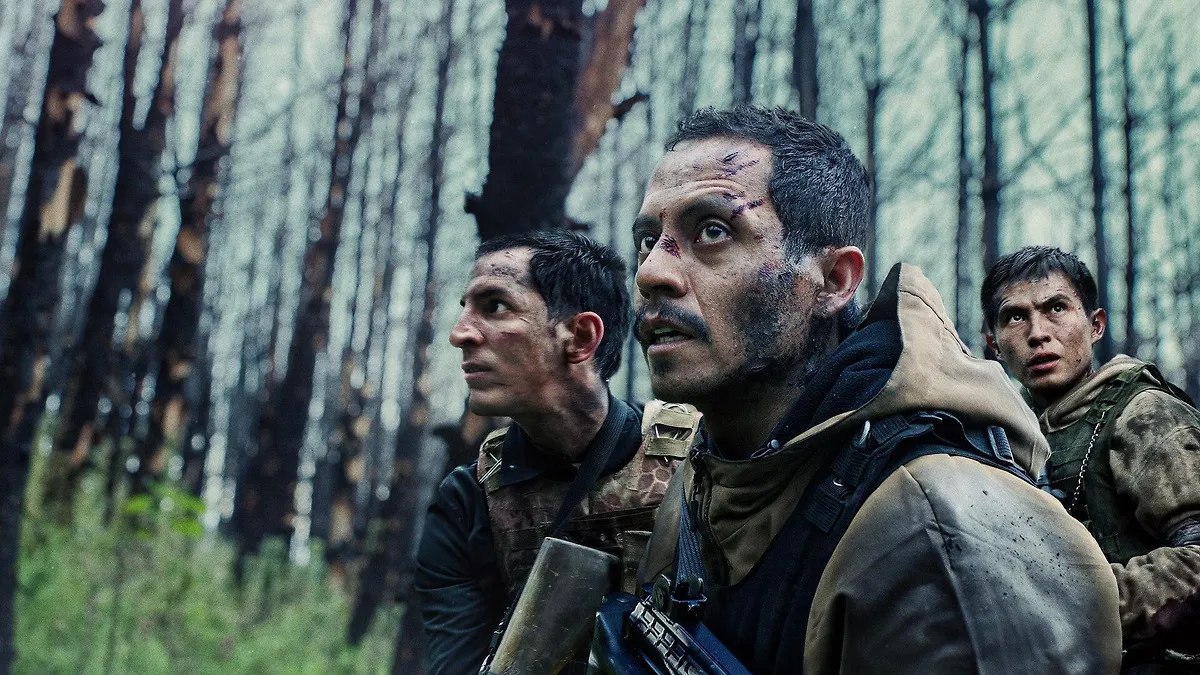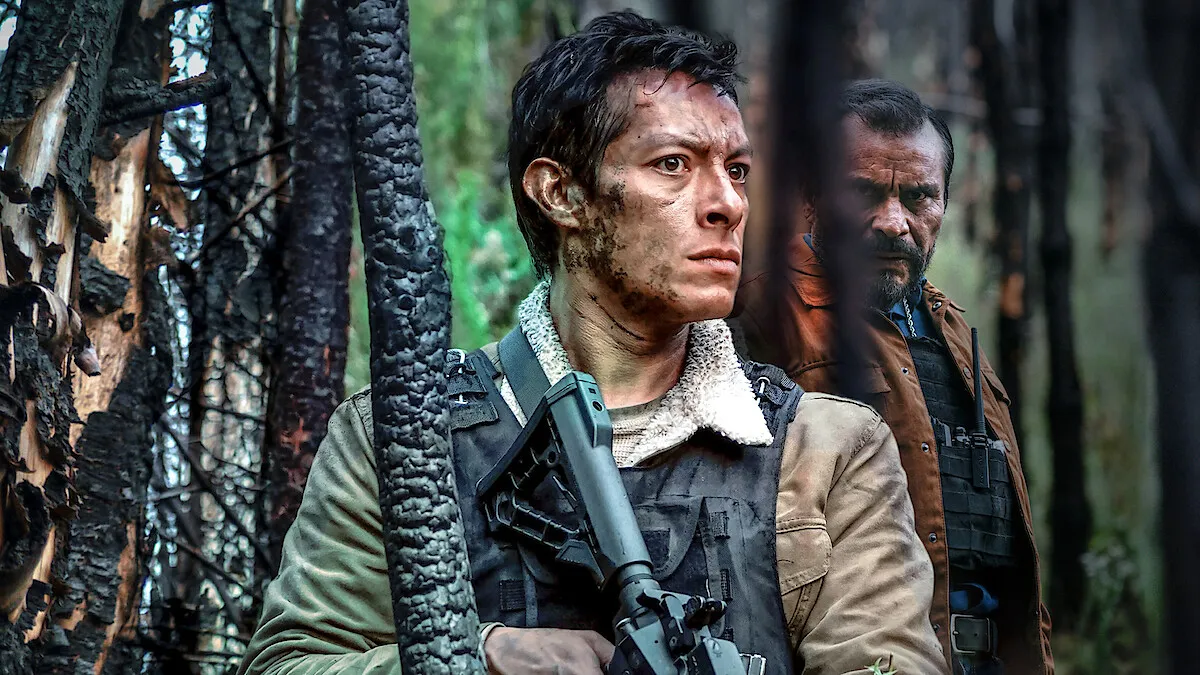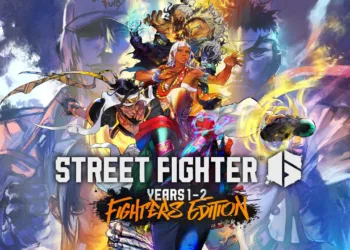Counterstrike emerges as a brisk, no-nonsense action thriller, pitting an elite Mexican commando unit—known as the Murcielagos—against a formidable cartel in a tense battle for survival. The plot unfolds when Captain Armando Guerrero and his team of hardened soldiers are thrust into an unexpected fight after their vacation is violently interrupted. What begins as a break from duty quickly turns into a desperate struggle for life as the soldiers are ambushed by the cartel, setting off a relentless chase across Mexico’s treacherous wilderness.
At the heart of this relentless survival tale is the film’s sharp, uncomplicated narrative, grounded firmly in the genre’s familiar action tropes: camaraderie among soldiers, relentless gunfights, and near-impossible odds. Counterstrike leans into these tropes, offering a streamlined, almost mechanical progression of action sequences, each more intense than the last. The stakes are clear—if the Murcielagos are to survive, they must outwit and outlast their merciless pursuers, a task complicated further by limited resources and no backup.
Captain Guerrero, portrayed with quiet charisma by Luis Alberti, is the rock-solid anchor around which this group of soldiers rallies. His bond with his team—Tanque, Pollo, Toro, and Combo—forms the emotional backbone of the film. Though the characters are drawn with a simplicity that prioritizes function over depth, their camaraderie offers a visceral connection that anchors the otherwise high-octane narrative. Their mission isn’t merely about survival; it’s deeply personal, as the men not only fight for their lives but also for a sense of justice against a cartel that has wronged them and their country.
Counterstrike: A Tightrope Walk Between Survival and Simplicity
The inciting incident of Counterstrike unfolds with a brutal clarity that sets the stage for its relentless pace. What begins as a rare moment of respite for Captain Guerrero and his team—an 85-minute window of leisure—is violently shattered by the cartel’s retaliation. A collision with an oncoming truck, followed by a well-executed ambush, immediately propels the Murcielagos from a casual vacation into a brutal fight for survival.
This swift transition from peace to chaos is almost too seamless, the quiet of their brief respite now only serving to heighten the tension of what follows. The film thus throws its characters, and by extension, its audience, into the maelstrom of a high-stakes chase where every moment counts.
At the core of Counterstrike lies the rivalry between Guerrero and the cartel, specifically their leader, Josefo Urias. His motivation to avenge his father’s death by the hands of elite soldiers from the Murcielago unit sharpens the film’s conflict into a tale of personal vendettas. The revenge-driven fury of Josefo is as much about preserving his violent legacy as it is about targeting the soldiers who symbolically represent the state’s intrusion into his world of unchecked criminal power. The simplicity of this motivation offers a clear moral compass for the audience: the Murcielagos are the steadfast good, and the cartels, driven by greed and retribution, the unrelenting evil.
The narrative structure of Counterstrike is built on this simplicity—there are no complicated subplots or deep dives into the personal histories of its characters. The film’s storytelling is unambiguous, almost to a fault. Each sequence is a direct reaction to the last, with the plot careening from one action beat to the next. This lack of narrative complexity leaves little room for character development beyond surface-level motivations, but in a film that aims to thrill with pure survival tension, this is not necessarily a flaw. Rather, it keeps the film lean and focused, allowing for its 85-minute runtime to unfold with an economy of time and purpose.
With a directness that some might criticize for its lack of depth, Counterstrike prioritizes momentum over nuance. Every frame seems designed to drive the story forward, ensuring that the audience remains on edge from one firefight to the next, with little in the way of unnecessary filler. The pacing is relentless, each moment designed to heighten the tension, making the film feel like a continuous rush of adrenaline. In its simplicity, Counterstrike distills the essence of its genre—no distractions, just survival, revenge, and the primal instinct to fight back.
Counterstrike: A Roster of Archetypes in the Service of Camaraderie
At the heart of Counterstrike stands Captain Armando Guerrero, a man whose moral clarity shines through in an otherwise simple narrative. Portrayed by Luis Alberti, Guerrero is the quintessential leader: steady, decisive, and unwavering in his commitment to his team and his country. His charisma lies in the quiet strength of his convictions, which anchor the film’s more chaotic moments.
He is not a figure mired in personal conflict or moral ambiguity; instead, Guerrero embodies a sense of duty that is as old as the action genre itself. In a world where leadership is often clouded by self-doubt or complex motivations, Guerrero remains resolutely clear-eyed, an admirable leader whose decisions are driven by the integrity of his mission. He doesn’t need to be introspective or tortured by past sins; his authority is in his actions, and the film knows not to overcomplicate his role. In a way, this simplicity becomes his greatest strength.
Supporting him is the team of soldiers who, while barely sketched out beyond their nicknames—Tanque, Pollo, Toro, Combo—form a believable, cohesive unit. These characters serve not so much as individual personalities but as representations of loyalty, camaraderie, and unspoken bonds. They are, in essence, archetypes that the narrative asks the audience to accept and invest in despite their lack of fleshed-out backstories.
This lack of individual depth is not a flaw, but rather a conscious decision, as it allows the film to focus on the collective dynamic between these soldiers. The bond they share is both palpable and essential to the film’s success. These men are not just soldiers—they are a family, and their shared experiences, marked by constant danger, make them easy to invest in emotionally.
In contrast, the villains are drawn with the same clarity but in a far less sympathetic light. Josefo Urias, played by Noé Hernández, and his brother Roman, serve as embodiments of vengeful cruelty. The simplicity of their motivations—revenge and greed—may make them feel one-dimensional, but in a film that thrives on archetypal roles, this is a necessary evil.
The villains need no complex backstory to justify their actions, only the undeniable fact that they stand in opposition to Guerrero and his team. Their drive to avenge their father’s death by eliminating the Murcielagos is straightforward but effective, creating a clear antagonist for the audience to root against.
The real heart of the film, however, lies not in the villains, but in the camaraderie between the soldiers. The dynamics between Guerrero and his team, though underexplored, are what breathe life into the narrative. There is a quiet grace to their interactions, a palpable sense of unity forged through shared danger. In a genre often dominated by individual heroes, Counterstrike finds its strength in collective survival, making the film’s emotional resonance one of solidarity rather than singular heroism.
Chava Cartas’ Tension-Fueled Precision in Action Filmmaking
Chava Cartas’ direction of Counterstrike showcases a keen understanding of pacing and tension. In a genre often guilty of excess, Cartas is a master of restraint. With an 85-minute runtime, he knows exactly how to keep the narrative flowing without overstaying its welcome. The film never lingers too long on any one scene, instead favoring a series of high-stakes moments that propel the story forward without losing momentum.
This efficiency in storytelling heightens the urgency of the soldiers’ plight, as each second feels weighted with the potential for danger. The film becomes a sprint rather than a marathon, where every moment is earned through Cartas’ careful orchestration of pace. His approach ensures that the tension never evaporates; instead, it builds steadily, leaving little room for the audience to catch their breath.
The visual aesthetics of Counterstrike are equally integral to its effectiveness. Cartas takes full advantage of the natural landscapes, using the wilderness not merely as a backdrop, but as an active participant in the story. The harsh terrain becomes an extension of the conflict itself—treacherous, unforgiving, and claustrophobic. The cinematography reflects this, with the camera often weaving between trees, narrow pathways, and rugged hills, creating a sense of constant peril.
A standout moment is the arrest of El Marrano, where the camera glides smoothly through a gap between two characters, capturing a moment of tension in an otherwise routine operation. This inventive use of perspective, combined with Cartas’ ability to frame each shot with precision, allows the film’s visual style to stand out as a true collaborator in its storytelling.
The action sequences, though straightforward, are executed with a grounding in realism that elevates the film’s intensity. Cartas avoids the temptation of over-the-top spectacle, focusing instead on the grit and brutality of the Murcielagos’ survival. The close-quarter combat and ambush scenes are particularly striking, as the soldiers navigate hostile terrain, constantly aware of the looming threat.
These sequences are visceral—raw in their realism and urgent in their execution. The practical effects are noteworthy, with explosions and gunfights feeling tangible and immediate. The film never indulges in the fantasy of invincible heroes or impossible stunts; every blow, every shot, is felt, and the stakes are palpable.
Sound and editing play an essential role in heightening the visceral experience of Counterstrike. The sound design complements the rawness of the action, with the sharp crack of gunfire cutting through the otherwise silent, oppressive wilderness. The editing mirrors this intensity—tight and unflinching, it creates an almost tactile sense of chaos during firefights, without the disorienting overload that often plagues action films.
The deliberate pacing of cuts, particularly in moments of high tension, amplifies the sense of danger, ensuring that each battle feels immediate and full of consequence. The balance between sound, visuals, and editing is a testament to Cartas’ ability to construct a high-energy, immersive experience without resorting to artificial flourishes.
The Clash of Ideals and Power
Counterstrike constructs its narrative around a stark, almost old-fashioned dichotomy of good versus evil, where the Murcielagos—elite soldiers embodying honor and duty—face off against the corrupt, merciless forces of the cartel. This binary structure is not a fault of the film but rather its central spine, providing a framework for exploring deeper themes of heroism, sacrifice, and the moral weight carried by soldiers on the battlefield.
The Murcielagos are unwavering in their commitment to justice, not for glory or self-interest, but for a sense of moral duty to their country and each other. In a genre often oversaturated with morally ambiguous protagonists, Counterstrike resists that trend, offering a rare portrayal of soldiers who are straightforward in their righteousness. Their honor is a matter of fact, not of choice, as they move through the treacherous wilderness with one goal: survival. In this sense, the film raises a quiet, unspoken question—what does it mean to serve with unflinching honor in a world rife with corruption?
While Counterstrike offers little room for personal development, the camaraderie between Guerrero and his team functions as the emotional heart of the film. The bond between these men is palpable, an unspoken understanding forged through shared experiences, trust, and the constant specter of danger.
Their teamwork is less about individual valor and more about a collective strength that allows them to overcome the overwhelming odds stacked against them. It is in their quiet solidarity, their unshakable faith in one another, that the film finds its most powerful emotional beat. Each soldier, no matter how minimally drawn, serves as part of the larger whole, contributing to the narrative’s underlying message about unity in the face of adversity.
The film also touches on the theme of corruption through the brief but significant presence of Secretary Arvizu, whose betrayal of the soldiers—leaking their location to the cartel for personal gain—adds an additional layer of moral complexity. While his role is fleeting, the implications of his actions reverberate throughout the story. Arvizu’s character introduces the idea that corruption is not confined to the criminal world but extends into the very institutions meant to uphold justice, exposing the system’s vulnerabilities.
The cartel, led by the vengeful Josefo Urias, serves as a powerful symbol of unchecked violence and greed. The cartel’s sheer brutality is a force that exists outside the laws of morality, driven solely by the pursuit of power, wealth, and revenge. Their dominance in the film serves as a stark contrast to the Murcielagos’ loyalty—both to their country and each other.
The cartel’s power is embodied not just in their weapons but in the insidious way they control and manipulate, ensuring their grip on the land is both unyielding and all-consuming. In this world, where loyalty and honor are rare commodities, the Murcielagos’ sense of duty becomes a radical act of resistance against the overwhelming tide of violence and corruption that surrounds them.
Action as Narrative Force, Not Spectacle
Counterstrike thrives on an action-oriented narrative, its story unfolding through a series of firefights, ambushes, and close-quarters combat. These sequences, relentless and unforgiving, form the backbone of the film, propelling its pace with an intensity that refuses to relent. Each skirmish is not simply a spectacle but an extension of the soldiers’ plight, a manifestation of their struggle for survival.
The action is tightly woven into the fabric of the narrative, pushing the plot forward rather than distracting from it. There’s an almost surgical precision to the way these scenes are designed, ensuring that each confrontation has purpose and urgency.
The stakes are constantly elevated, with each firefight heightening the sense of impending doom that looms over the Murcielagos as they fight their way through the wilderness. The film operates as a continuous pulse of adrenaline, where each combat encounter feels like the last chance for escape, and the line between victory and defeat blurs with every encounter.
What is striking about the film’s handling of action is its balance between realism and entertainment. In an era where action films often fall prey to exaggerated stunts and impossible feats, Counterstrike refrains from veering into the realm of hyperbole. The military tactics, though not meticulously detailed, are grounded in a sense of practical survival, with the soldiers relying on their training and wits to navigate hostile territory.
There are no flashy, over-the-top moments designed solely for spectacle; instead, each tactical move, each burst of gunfire, is calibrated to feel authentic. The film’s action is not about showcasing the invincibility of its heroes but about making their struggle feel tangible, believable, and, at times, terrifyingly futile. In this way, Counterstrike earns its action moments, allowing them to retain their impact without resorting to the escapism often found in larger, more bombastic films.
The portrayal of violence in Counterstrike is similarly restrained. It does not glorify the bloodshed but uses it as a tool to underscore the film’s themes of desperation and survival. The violence is blunt and unrelenting, a means to highlight both the ruthlessness of the cartel and the soldiers’ own struggle to hold on to their humanity in the face of overwhelming odds.
There’s no celebratory tone to the bloodshed; each fight is a grim reminder of the high cost of survival. The physical toll on the soldiers is evident, not just in their injuries but in the weariness that marks their every movement. Violence is not something to be cheered or reveled in; it’s simply a brutal fact of their world, a reminder of the stakes that weigh heavily on every decision.
In contrast to many films that rely heavily on CGI or stunt doubles, Counterstrike is notable for its practical effects and the apparent physicality of its actors. There’s an authenticity to the action here—fights are raw, not polished, with the actors seeming to throw themselves into the physicality of each scene.
The actors’ involvement in the stunts adds a layer of grit to the film, creating a sense of realism that further immerses the viewer in the experience. The exhaustion, the dirt, the sweat—these elements are not merely cosmetic; they serve as a testament to the commitment of both the filmmakers and the cast to tell a story that feels as grounded as the terrain it depicts.
Survival Over Substance in a World of Violence
Counterstrike is an action film that excels in its simplicity, delivering a solid dose of military survival drama without veering into overcomplicated plots or characters. Its appeal lies in its no-frills approach, where the narrative is driven entirely by action, survival, and the bond between a tight-knit group of soldiers.
The film doesn’t bother with deep character arcs or moral quandaries; instead, it offers a visceral experience centered on the relentless tension of the soldiers’ struggle against both the elements and the cartel. In a world where modern action films often burden themselves with excessive subplots or attempts at intellectual gravitas, Counterstrike finds success by embracing its genre conventions without apology.
The film’s strength lies in its tight pacing, the strong camaraderie between its leads, and the effectiveness of Chava Cartas’ direction. The action is immediate, engaging, and unpretentious, while the ensemble cast, despite their limited development, shines in their collective effort. However, the film does falter in its lack of character depth, with minimal emotional exploration or nuance. The simplistic plotting—though not a fault in itself—limits the film’s potential to transcend the usual action fare.
Full Credits
Director: Chava Cartas
Writer: José Rubén Escalante Méndez
Producers: Francisco González Compeán, Sebastián Jurado
Cast: Luis Alberti (Capitán Armando Guerrero), Noé Hernández (Josefo “El Aguijón” Urías), Leonardo Alonso (Dámaso “Tanque”), Luis Curiel (Jorge “El Pollo”), David Calderón León (El Combo), Guillermo Nava (El Toro), Mayra Batalla (Lucía), Ishbel Bautista (La Cobra), Israel Islas (Román “El Sacristán” Urías), Frida Jiser (Karla), César Antulio (Agente Fiscal), Roberta Burns (Teniente Atenea), José Luis Enríquez (Joaquín), Mario Escalante (Lalo ‘El Marrano’), Alejandra Herrera (Sargento Quetzal), Pedro Joaquín (Chucho), Sergio Jurado (Secretario Arvizu), Mario Alberto Monroy (Tuco), Edgar Novoa (Agente Márquez), Alberto Ornelas (Maik), Guillermo Quintanilla (Coronel Marcelo Díaz), Luz Ramos (Teniente Stum), Manuel Villegas (Adalberto)
Director of Photography (Cinematographer): Beto Casillas
Editors: Sam Baixauli, Carlos Silva Vallejo
Composer: Víctor Hernández Stumpfhauser
Distributor: Netflix
The Review
Counterstrike
Counterstrike delivers a high-energy, action-packed survival story that thrives on simplicity. With its lean narrative, intense firefights, and solid camaraderie among its soldiers, the film offers exactly what action fans expect—no more, no less. While it lacks deeper character exploration or a complex plot, its efficient direction and visceral action sequences make for a satisfying, if straightforward, experience. For those seeking unadulterated military action, Counterstrike hits the mark without overstaying its welcome.
PROS
- Tight pacing keeps the action flowing without unnecessary downtime.
- Strong camaraderie between the ensemble cast, despite minimal character development.
- Realistic action scenes with practical effects and physical performances.
- Effective direction from Chava Cartas that heightens tension and suspense.
CONS
- Lack of character depth leaves the soldiers feeling like archetypes rather than fully realized individuals.
- Simplistic plot with few twists or deeper narrative layers.
- Minimal exploration of emotional stakes beyond the immediate survival context.















